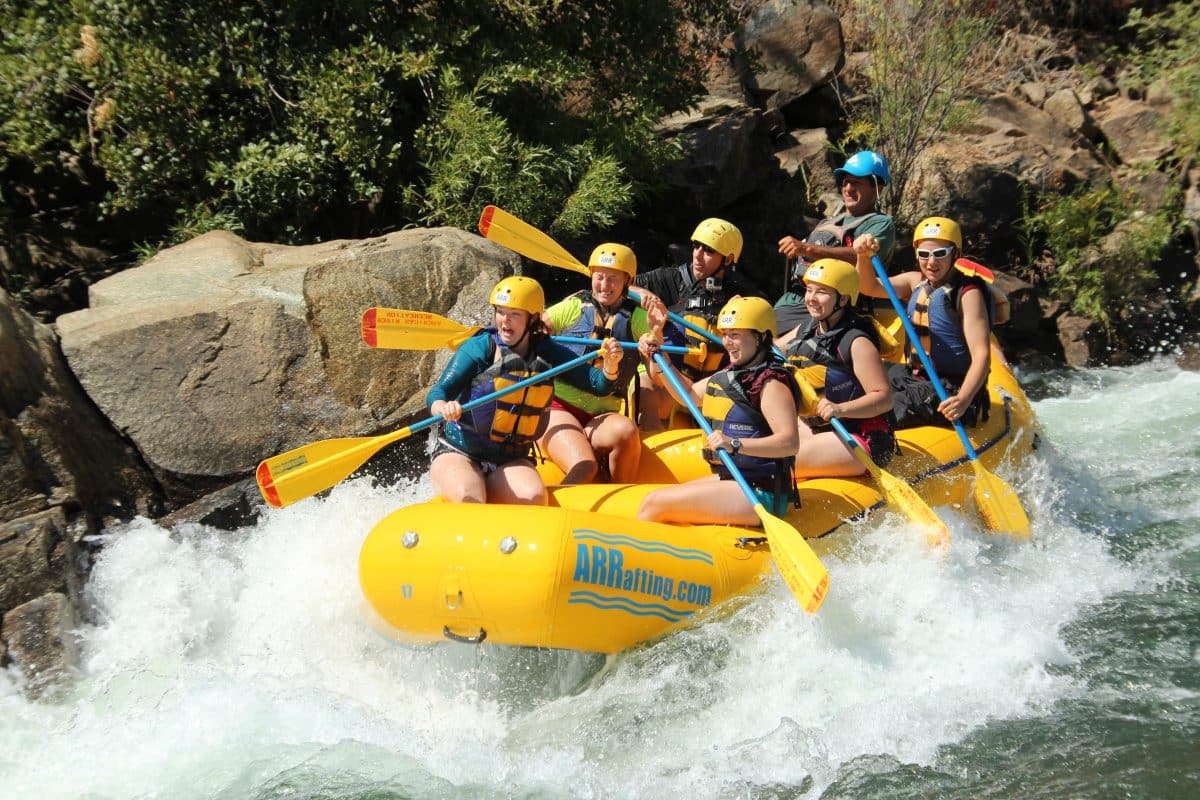
SOUTH FORK AMERICAN RIVER RAFTING
Rush to California’s World Famous River Rafting Run
South Fork American Rafting is perfect for ages 6 and up and all experience levels
The South Fork American River flows 21 beautifully unbridled miles of exciting class III whitewater rafting. Over 25 major river rapids cut through some of the most stunning and varied geology in the High Sierra, including such ominous-sounding rapids as Meat Grinder, Troublemaker, Satan’s Cesspool, and Hospital Bar! The South Fork is an all-aged playground with world-class rafting to accommodate a wide range of participants. Intermediate whitewater rafting allows for an exciting and scenic experience for families, friend and social groups, and individuals. Hold on tight; it’s going to be a wild ride!
Once Spring has sprung, the rafting season is in full swing. This season sees vibrant green rolling hills, unfolding beauty in oak woodlands, native birds swimming with their young, and enthusiastic rafters charging down the river on a heart-pumping adventure. Spring can bring high excitement as water levels can have more flow variance. Participants will be outfitted in wetsuits and splash tops to adjust for spring temperatures.
The peak of rafting season popularity on the South Fork occurs in Summer months. Coloma is an excellent destination for a summer vacation with friends and family or a solitary retreat. Guest will experience warm weather, guaranteed river flows, camping and meal options, and many other activities nearby.
Half-Day Trips start at $79!
Last Minute Bookings Welcome – Reserve Today and Raft Tomorrow!
American River Rafting Logistics
All South Fork trips leave from the American River Resort, a beautiful campground with full hook-up RV sites, tent camping designations, stand-alone cabins, and hot showers. By staying overnight, guests have the option to enjoy the 21-mile stretch of river over multiple days. Off-river time can be spent relaxing in the pool or watching rafts navigate one of the rivers premiere rapid, Troublemaker, which can be seen from the campground. American River Resort is perched on the river and is rich in biodiversity. The area can be utilized for a variety of other recreational activities. Activities such as these including bird watching, hiking, biking, fishing, kayaking, and more. For a worry-free approach to camping, take part in delicious dinners with other rafting guest and enjoy a fabulous three-course meal provided by the Resort staff.
Full day rafting trips on the South Fork have guests meeting in the morning to receive a briefing from the Rafting Trip Leader. They explain what the day entails, give a group safety briefing, and match guests with a personable, experienced guide. The guide goes over proper rafting techniques and develops the team dynamic before embarking on an unforgettable downstream journey. Together guests and guide navigate class II and III rapids, all the while, laughing and telling stories and inevitably build up a bit of an appetite. At a designated point on the trip, rafts pullover to relish in a gourmet riverside lunch that river staff prepares. The tour doesn’t end there; rafts continue to loom through the big-hitting rapids of the gorge. Transportation will await guests’ arrival at the end of the river. Rafters will load up and travel back to the American River Resort, where they can have a good laugh at photos from the day. Half day rafting trips are carried out much the same, with morning and afternoon trip options, ideal for those with limited time or those wanting a later start.
Geographical Location and History of the American River
There are three major forks of the American river that span Placer County, El Dorado County, and Sacramento County. The South Fork American River is one of California’s vital waterways as is the entire American River watershed. Water accumulates from snowmelt off the Western slope of the Sierra Nevada Mountain Range in El Dorado National Forest and Desolation Wilderness. The river takes form outside of South Lake Tahoe. The snowmelt courses along one-million-year-old granite slabs, paralleling Highway 50 toward Historic Hangtown, or Placerville. Once in the foothills, the river furrows the limestone in a serine sunlit gorge filled with exciting class III whitewater all the way to Coloma. Just beyond American River Resort, in Coloma, the river is a central feature of Marshall Gold Discovery State Historic Park. The North and Middle Forks of the American River eventually come together and meet the South Fork in Folsom Lake, East of California’s Capital City. The American River then feeds into the Sacramento River with the Sacramento Metropolitan Airport it’s Eastbank. The collective of water will eventually end up in the San Francisco Bay Area. Much of the river is found on public land with the oversight of United States Forest Service, California State Parks and Bureau of Land Management. Like many other recreational rivers in the United States, the American River benefits from the environmental advocacy of American Whitewater, a nonprofit with the mission, “to conserve and restore America’s whitewater resources and to enhance opportunities to enjoy them safely.”
From Chili Bar Reservoir to Folsom Lake, the South Fork American River passes areas that are rich in California Gold Rush History. Downstream of American River Resort, rafts navigate adjacent to Sutter’s Mill; the location of James W. Marshall gold discovery on January 24th of 1948. This event was responsible for the migration of some 300,000 people from other parts of the United States and abroad. At this time the population was over 500 times greater than the current population residing in the quaint town of Coloma. These Forty-niners flocked to the “Mother Lode” and were the keystone in the building of roads, schools, businesses, churches, neighboring towns, and ultimately making California a State in September of 1850. The town post office was established in 1849 under the name Culloma, but was changed to Coloma in 1851. The name Culloma comes from a word meaning, “beautiful” in the Nisenan Native American language, a tribe native to the Coloma Valley. The Gold Rush officially ended in 1855, but that seven years of economic stimulus was crucial in shaping the California we know today.
Coloma, California was declared a National Historic Landmark District on July 4th of 1961 based on the happenings of 1848-1855. The prominent history, rafting, and other forms of river recreation are the defining features of Coloma and drive the local economy. Many establishments operate only in the warmer months to accommodate the influx of tourism.
Experience the Rush of Whitewater Rafting on the South Fork American River

